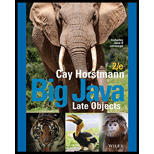
Big Java Late Objects
2nd Edition
ISBN: 9781119330455
Author: Horstmann
Publisher: WILEY
expand_more
expand_more
format_list_bulleted
Question
Chapter 12, Problem 2PE
Program Plan Intro
Invoice
Program plan:
Filename: “Address.java”
This program file is used to define a class “Address”. In the code,
- Define a class “Address”.
- Define the class members.
- Define a constructor “Address()”.
- Set the values for class members.
- Define a method “format()”.
- Return the address.
Filename: “Invoice.java”
This program file is used to define a class “Invoice”. In the code,
- Import the required packages.
- Define a class “Invoice”.
- Define the class members.
- Define a constructor “Invoice()”.
- Set the class elements.
- Define the method “add()”.
- Create an object “anItem” of class “LineItem”.
- Call the method “add()” recursively.
- Define a class “format()”.
- Define the constants “DESCRIPTION_WIDTH”, “PRICE_WIDTH”, “QTY_WIDTH”, “TOTAL_WIDTH”.
- Define a string variable “r”.
- Define an array “widths[]”.
- Assign the constants of width to the array “widths[]”.
- Iterate a “for” loop,
- Call the method “format(widths)” and add the result to “r”.
- Call the method “format” and add the result to “r”.
- Return “r”.
- Call the method “format(widths)” and add the result to “r”.
- Define a method “getAmountDue()”.
- Define the variable “amountDue”.
- Iterate a “for” loop,
- Calculate the value of “amountDue”.
- Return the value of “amountDue”.
- Calculate the value of “amountDue”.
Filename: “LineItem.java”
This program file is used to define a class “LineItem”. In the code,
- Import the required packages.
- Define a class “LineItem”.
- Define the class members.
- Define a constructor “LineItem()”.
- Set the class elements.
- Define a method “getTotalPrice()”.
- Multiply the price and quantity and return the result.
- Define the method “format”.
- Define the variables.
- Call the method “getDescription()” and assign the value to “description”.
- Call the method “getCurrencyInstance()”.
- Define a string “r” to hold the formatted details of a product.
- Return the value of “r”.
Filename: “Product.java”
This program file is used to define a class “Product”. In the code,
- Import the required packages.
- Define a class “Product”.
- Define the class members.
- Define a constructor “Product()”.
- Set the class elements.
- Define a method “getDescription()”.
- Return the “description”.
- Define a method “getPrice()”.
- Return the “price”.
Filename: “InvoicePrinter.java”
This program file is used to define a class “InvoicePrinter”. In the code,
- Define a class “InvoicePrinter”.
- Define a method “main()”.
- Define the object “samsAddress” of class “Address”.
- Define the object “samsInvoice” of class “Invoice”.
- Call the method “add()” using “samsInvoice” to add the products.
- Print the invoice using “samsInvoice”.
- Define a method “main()”.
Expert Solution & Answer
Want to see the full answer?
Check out a sample textbook solution
Chapter 12 Solutions
Big Java Late Objects
Ch. 12.1 - Prob. 1SCCh. 12.1 - Prob. 2SCCh. 12.1 - Prob. 3SCCh. 12.1 - Prob. 4SCCh. 12.1 - Prob. 5SCCh. 12.2 - Prob. 6SCCh. 12.2 - Prob. 7SCCh. 12.2 - Prob. 8SCCh. 12.2 - Prob. 9SCCh. 12.2 - Prob. 10SC
Ch. 12.2 - Prob. 11SCCh. 12.2 - Prob. 12SCCh. 12.3 - Prob. 13SCCh. 12.3 - Prob. 14SCCh. 12 - Prob. 1RECh. 12 - Prob. 2RECh. 12 - Prob. 3RECh. 12 - Prob. 4RECh. 12 - Prob. 5RECh. 12 - Prob. 6RECh. 12 - Prob. 7RECh. 12 - Prob. 8RECh. 12 - Prob. 9RECh. 12 - Prob. 10RECh. 12 - Prob. 11RECh. 12 - Prob. 12RECh. 12 - Prob. 13RECh. 12 - Prob. 14RECh. 12 - Prob. 15RECh. 12 - Prob. 1PECh. 12 - Prob. 2PECh. 12 - Prob. 3PECh. 12 - Prob. 4PECh. 12 - Prob. 5PECh. 12 - Prob. 6PECh. 12 - Prob. 1PPCh. 12 - Prob. 2PPCh. 12 - Prob. 3PPCh. 12 - Prob. 4PPCh. 12 - Prob. 5PPCh. 12 - Prob. 6PPCh. 12 - Prob. 7PPCh. 12 - Prob. 8PPCh. 12 - Prob. 9PPCh. 12 - Prob. 10PP
Knowledge Booster
Recommended textbooks for you
 Database System ConceptsComputer ScienceISBN:9780078022159Author:Abraham Silberschatz Professor, Henry F. Korth, S. SudarshanPublisher:McGraw-Hill Education
Database System ConceptsComputer ScienceISBN:9780078022159Author:Abraham Silberschatz Professor, Henry F. Korth, S. SudarshanPublisher:McGraw-Hill Education Starting Out with Python (4th Edition)Computer ScienceISBN:9780134444321Author:Tony GaddisPublisher:PEARSON
Starting Out with Python (4th Edition)Computer ScienceISBN:9780134444321Author:Tony GaddisPublisher:PEARSON Digital Fundamentals (11th Edition)Computer ScienceISBN:9780132737968Author:Thomas L. FloydPublisher:PEARSON
Digital Fundamentals (11th Edition)Computer ScienceISBN:9780132737968Author:Thomas L. FloydPublisher:PEARSON C How to Program (8th Edition)Computer ScienceISBN:9780133976892Author:Paul J. Deitel, Harvey DeitelPublisher:PEARSON
C How to Program (8th Edition)Computer ScienceISBN:9780133976892Author:Paul J. Deitel, Harvey DeitelPublisher:PEARSON Database Systems: Design, Implementation, & Manag...Computer ScienceISBN:9781337627900Author:Carlos Coronel, Steven MorrisPublisher:Cengage Learning
Database Systems: Design, Implementation, & Manag...Computer ScienceISBN:9781337627900Author:Carlos Coronel, Steven MorrisPublisher:Cengage Learning Programmable Logic ControllersComputer ScienceISBN:9780073373843Author:Frank D. PetruzellaPublisher:McGraw-Hill Education
Programmable Logic ControllersComputer ScienceISBN:9780073373843Author:Frank D. PetruzellaPublisher:McGraw-Hill Education

Database System Concepts
Computer Science
ISBN:9780078022159
Author:Abraham Silberschatz Professor, Henry F. Korth, S. Sudarshan
Publisher:McGraw-Hill Education

Starting Out with Python (4th Edition)
Computer Science
ISBN:9780134444321
Author:Tony Gaddis
Publisher:PEARSON

Digital Fundamentals (11th Edition)
Computer Science
ISBN:9780132737968
Author:Thomas L. Floyd
Publisher:PEARSON

C How to Program (8th Edition)
Computer Science
ISBN:9780133976892
Author:Paul J. Deitel, Harvey Deitel
Publisher:PEARSON

Database Systems: Design, Implementation, & Manag...
Computer Science
ISBN:9781337627900
Author:Carlos Coronel, Steven Morris
Publisher:Cengage Learning

Programmable Logic Controllers
Computer Science
ISBN:9780073373843
Author:Frank D. Petruzella
Publisher:McGraw-Hill Education